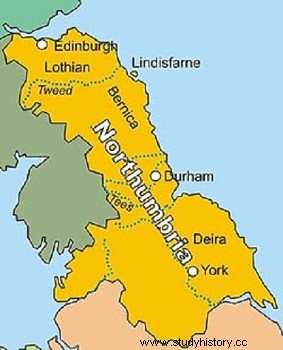
Northumbria (Latin:Northumbria, Old English:Norþanhymbra) is a medieval kingdom located in present-day northern England and was one of the main kingdoms of the Heptarchy. Its notoriety is above all linked to its role in the propagation of Nicene Christianity on the island and to the constitution of a cultural center of European importance with the Archbishopric of York.
The name Northumbria originally referred to the lands invaded by the Angles in the 6th century located north of the Humber River. Northumbria as a kingdom was formed at the beginning of the 7th century by the union of two other Angle entities:that of Bernicie (Bernicia) in the north and that of Deirie (Deira) in the south.
The history of the kingdom is essentially known through the work of Bede the Venerable, an English monk from Northumbria from the beginning of the 8th century who left an Ecclesiastical History of the English people. In it, he recounts the conversion of the Anglo-Saxons to Nicean Christianity, first under the action of missionaries from the continent, then under that of English saints. It is remarkable that from the time of Bede the Northumbrians of Deirie and Bernicia were conscious of belonging, with the other Germanic inhabitants of the island, to the same people.
Training and conversion
Northumbria was united for the first time under the reign of Æthelfrith of Bernicia, at the beginning of the 7th century. On his death in 616, his rival and brother-in-law Edwin of Deira succeeded him. This pagan king of the Angles converted to Christianity in 627 under the action of his wife, a daughter of the Christian king Æthelbert of Kent, and under the influence of the missionary Paulinus of York who accompanied the future wife.
This unit, like the recent conversion of the Northumbrian Angles, is quickly called into question. In 633, Edwin was defeated and killed at Hatfield Chase by the Breton king Cadwallon, whose people he had previously subjugated. In addition, the rise to power of King Penda of Mercia, a staunch defender of paganism, temporarily interrupted the progress made by Christian missionaries.
In 634, Oswald of Bernicia reunited Northumbria after defeating Cadwallon near Hexham. In order to evangelize his people, he brought from Iona the Scottish missionary Aidan, who founded an abbey at Lindisfarne, and the country was quickly converted by Scottish monks. Oswald's support for Christianity and his martyrdom at the hands of Penda in 641 earned him sanctification. The opposition between Mercia and Northumbria culminated in the Battle of Winwaed in 654, during which Penda was defeated and killed by Oswiu, Oswald's successor.
The 7th century marks the peak of Northumbrian power:Kings Edwin, Oswald and Oswiu are singled out by Bede as having exercised imperium over the other Anglo-Saxon kingdoms. However, as early as 678 King Ecgfrith was defeated by the Mercians near the Trent, and in 685 he was crushed and killed by the Picts at Nechtansmere. The Anglo-Saxon progression towards the north of the island of Great Britain is interrupted on the Forth for several centuries, and the Northumbrian domination over the south of England disappears in favor of Mercia.
The Viking Age
In 793, the first major Viking attack in England was the sack of the monastery of Lindisfarne, on the Northumbrian coast. The kingdom was then in the grip of great instability:thirteen kings succeeded each other between the death of Aldfrith (704) and the attack on Lindisfarne, many of whom experienced violent deaths.
Taking advantage of a civil war between kings Ælle and Osberht of Northumbria, the Vikings of the "Great Army" seized York on November 1, 866 and made this then prosperous city the capital of a new state, the kingdom York viking. The two contenders for the throne ally and attempt to retake York in 867, but they die during this campaign. Southern Northumbria was settled by the Danes, while Norwegians from Ireland continued to plunder the region.
In 876, a new earldom of Bernicia was formed with the Earls of Bamburgh as rulers. In 918 Rognvald annexed Anglo-Saxon Northumbria to his kingdom of York.
The Anglo-Saxons of Wessex temporarily conquered it in 919-920 and then in 941-944. They did not manage to seize it until 954 when the last Viking king of York died.
In 664 the synod of Whitby took place in Northumbria. This major event shows the importance that Northumbria then acquired in the religious field:at the initiative of the Northumbrian king Oswy, the Celtic (Scottish) ecclesiastical tradition was confronted with the Latin tradition. The controversy relates in particular to the date of celebration of Easter. The question, which has torn the two Churches apart since the birth of the Anglo-Saxon Church, is decided in favor of the latter. From then on, the Scottish bishops left the kingdom of Northumbria; and the Anglo-Saxon Church (whose unity foreshadows the birth of England) in turn launches missions to the Celts:Iona finally accepts Nicaean Christianity under the influence of a Northumbrian missionary, Egbert, in 688 He even left for the continent and took part in the mission among the Frisians. His fellow citizens Wilfrid of York and Willibrord of Utrecht will follow his example.
History and events
604 Unification by Æthelfrith
633 Hatfield Chase; division of the kingdom
634 Reunification
5 August 642 Maserfield; separation from Deira
15 November 655 Winwaed; reunification
867 Northumbria becomes the Viking Kingdom of York
954 Death of Eric I, last Viking king of Northumbria
Previous entities :
Bernicie
Deira
Following entities :
Viking Kingdom of York
Kingdom of Scotland
